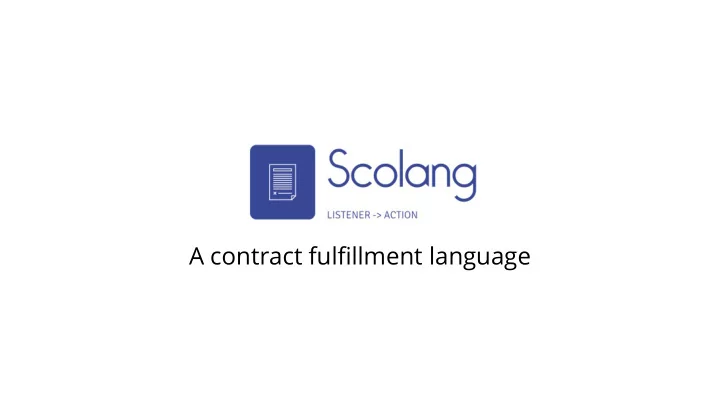

A contract fulfillment language
Contents 1. Motivation and Background 2. Implementation Details 3. How it works 4. Development Strategy and learnings 5. Demo
Motivation and Background Scolang is a “Smart Contracts” based language, this means that a listener ● gets fulfilled and it triggers an action Automate all the repetitive “IFTTT” tasks that users might have ● Versatile use cases - IoT, Networking, Load balancing… ○ Tried writing an “Alexa Skill” to turn on a phillips hue light and play some ● music = world of pain.
Implementation Details 1. Programming Paradigm 2. Data Types 3. Key inbuilt functions
Programming Paradigm Contract Reject Resolve Exit Listener Action Declare multiple contracts in one script and they’ll all be executed concurrently! Listener b = { println (“I’m a listener!”); resolve; }; Action a = { println(“I’m an action!”); }; a -> b; /* This is a contract */
Data Types Standard Data Types Integer 32 bit signed integer Boolean 1-bit Boolean variable Float 64-bit Float String 8 bit pointer Scolang Types Listener Function Pointer Action Function Pointer Contract Integer
Key Inbuilt Functions Purpose - Promoting IoT use case and versatility by allowing powerful contracts by having very open ended functions. 1. Webhook(port_number) : Opens a webhook at that port that’s waiting for an input 2. Query(query_details) : Send a query to an endpoint of your choosing 3. system_call(systemcall) : Execute cmd commands on your system Specifications 1. Statically scoped 2. Declarations must precede use/initialisation 3. Static types
How it works : Under the hood 1. Listeners are essentially functions waiting to either die or return 2. Actions are also essentially functions 3. Whenever a contract is encountered, the listener-action pair is bound and forked into its own program, parent program returns to create more children. During codegen, the compiler walks through the AST, casts actions/listeners to functions and then prepares the binding by calling a C-function we wrote that manipulates the pointers to execute sequentially
Compiler Architecture Ocaml Compiler source.sav scanner Parser Semant Codegen LLVM IR Tokens AST SAST IR to Executable LLVM IR Executable Std Lib
Development Strategy 1. Testing in Travis CI + Shared VM for inspection 2. Environment Preservation using Docker 3. Written in OCaml, Python, C 4. Communication and Task Management via Trello and Messenger Timeline B-Weekly sprints before due dates
Learnings 1. Start early and use the regression testing suite as much as possible 2. Don’t waste time on things that are not the compiler( wasted a lot of time on travis CI) 3. Be less ambitious (We originally wanted to have algebraic expressions across listeners and chaining) 4. Team work makes the dream work - contribution % was near 20% for all 5 members.
Demo - Solving the problem that initiated this entire project - Writing an alexa skill to turn on the lights and play some music. Sushanth Raman All rounder Jackson Chen Language Guru Sambhav Anand Architecture Varun Varahabhotla Project Manager Kanishk Vashisht Testing incharge
Recommend
More recommend